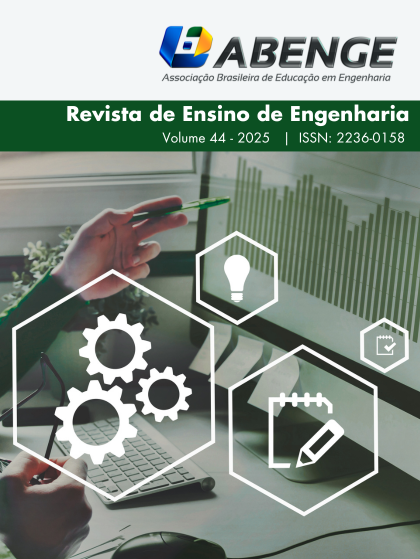PERCEPTIONS OF ENVIRONMENTAL ENGINEERING STUDENTS ABOUT ZOONOSES AND PANDEMICS
Keywords:
pandemias , Engenharia Ambiental, doenças zoonóticasAbstract
The present study aimed to analyze the perception of Environmental Engineering students about the possible relationships between zoonoses and the emergence of pandemics. To this end, questionnaires were applied in the form of an online form to 100 students during the period from August 7, 2023 to November 7, 2023. The questionnaire used questions about the profile of the respondents, closed and open questions with the aim of understanding in more detail the students' opinion on the topic investigated. To analyze the open questions, Content Analysis was used. It was possible to perceive that most of the students have considerable perception of the relationship between zoonoses and the emergence of pandemics. Furthermore, most respondents are able to understand the negative impacts of human actions, such as the lack of biosafety in animal handling and the expansion of deforestation and agribusiness. This confirms the importance of studies of this nature for the implementation of actions that contribute to the mitigation of environmental impacts.
References
ADHIKARI, S. P. et al. Epidemiology, causes, clinical manifestation and diagnosis, prevention and control of coronavirus disease (COVID-19) during the early outbreak period: a scoping review. Infectious Diseases of Poverty, v. 29, p. 1-12, 2020.
BARDIN, L. Análise de conteúdo. São Paulo: Edições 70, 2011.
BEYER, R. MANICA, A.; MORA, C. Shifts in global bat diversity suggest a possible role of climate change in the emergence of SARS-CoV-1 and SARS-CoV-2. Science of The Total Environment. v. 767, 2021.
BUSSAB, W.; MORETTIN, P. A. Estatística Básica. 5. ed. São Paulo: Saraiva, 2003.
COSTA, C.; MAROTI, P. Percepção ambiental e estudo do meio como ferramentas de educação ambiental formal, v. XXI, n. 80, 2022.
FAGGIONATO, S. Percepção ambiental. Materiais e Textos, n. 4, 2005.
FERNANDEZ, R. Mudança climática aumenta riscos de novas pandemias. Portos e navios. 2022. Disponível em: https://www.portosenavios.com.br/artigos/artigos-de-opiniao/artigo-mudanca-climatica-aumenta-riscos-de-novas-pandemias. Acesso em: 22 set. de 2024.
FIOCRUZ. A produção de alimentos, as mudanças climáticas e a saúde pública. Saúde e sustentabilidade. 2022. Disponível em: https://cee.fiocruz.br/?q=A-produ%C3%A7%C3%A3o-de-alimentos-as-mudan%C3%A7as-clim%C3%A1ticas-e-a-sa%C3%BAde-p%C3%BAblica. Acesso em: 10 out. de 2024.
GEBREYES, W. et al. The global on health paradigm: challenges and opportunities for tackling infectious diseases at the human, animal, and environment interface in low-resource settings. Plos Neglected Tropical Diseases, v. 8, e3257, 2014.
GUENEVARA, A. Sustentabilidade. Programa de Pós-Graduação em Administração e Programa de Pós-Graduação em Economia FEA/PUC-SP, 2020.
GHERNAOUT, D.; ELBOUGHDIRI, N. Environmental Engineering for Stopping Viruses Pandemics. Open Access Library Journal, v. 7, p. 1-17. 2020.
HENRIQUE, S. Pandemia, epidemia e endemia: significados e diferenças. SanarMed. 2020. Disponível em: https://www.sanarmed.com/epidemia-endemia-e-pandemia-seus-significados-e-suas-diferencas-colunistas. Acesso em: 10 out. de 2024.
JONES, K. i. Global trends in emerging infectious diseases. Nature, v. 451, p. 990-993, 2008.
MORAES, R. O Engenheiro Ambiental e o seu papel como ferramenta de transição para uma sociedade sustentável. ABES-SP, 2016.
MOURA, A.; ROCHA, R. Endemias e Epidemias: dengue, leishmaniose, febre amarela, influenza, febre maculosa e leptospirose. Belo Horizonte, Nescon UFMG, 2012.
OCDE. O impacto da pandemia de covid-19 é maior do que as piores previsões. 2020. Disponível em: https://www.publico.pt/2020/03/21/economia/noticia/ocde-impacto-pandemia-covid19-maior-piores-previsoes-1908849. Acesso em: 14 out. de 2024.
PORTAL DO BUTANTAN. Mudanças climáticas aumentam o risco de transmissão viral entre espécies. 2022. Disponível em: https://butantan.gov.br/noticias/mudancas-climaticas-aumentam-o-risco-de-transmis sao-viral-entre-especies. Acesso em: 14 set. de 2024.
RABELLO, A; OLIVEIRA, D. Impactos ambientais antrópicos e o surgimento de pandemias. UNIFESSPA. 2020.
SCHNEIDER, E.; FUJII, R. CORAZZA, M. J. Pesquisas quali-quantitativas: contribuições para a pesquisa em ensino de ciências. Revista Pesquisa Qualitativa, vol. 5, n. 9, p. 569-584, 2017.
SILVA, A.; LOPES, G. A pandemia de coronavírus e o Antropoceno. Agência Fiocruz de Notícias, 2020. Disponível em:https://www.researchgate.net/publication/348944758_A_pandemia_de_coronavirus_e_o_Antropoceno#fullTextFileContent. Acesso em: 21 jul. de 2025.
TAVARES, M. J. et al. Ações antrópicas e o surgimento de pandemias: qual o papel da engenharia ambiental nesse contexto? Research, Society and Development, v. 9, n. 8, p. 11-23. 2020.
VARÃO, C.; BATISTA, C.; MARTINHO, V. Métodos de amostragem. Departamento de Educação FCUL. Metodologia de Investigação I. 2005.
VOLPATO, G. et al. Baby pangolins on my plate: possible lessons to learn from the COVID19 pandemic. Journal of Ethnobiology and Ethnomedicine, v. 2020, p. 16-19, 2020.
ZANINI, A. et al. Estudos de percepção e educação ambiental: um enfoque fenomenológico. Ensaio Pesquisa em Educação em Ciências (Belo Horizonte), v. 23, n.3, p.12-28, 2021.


